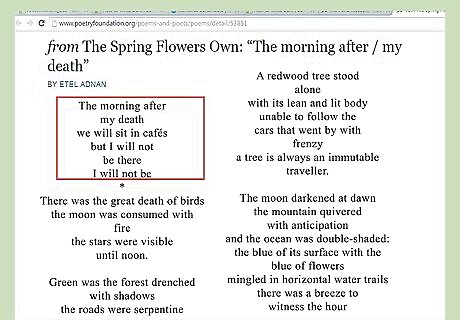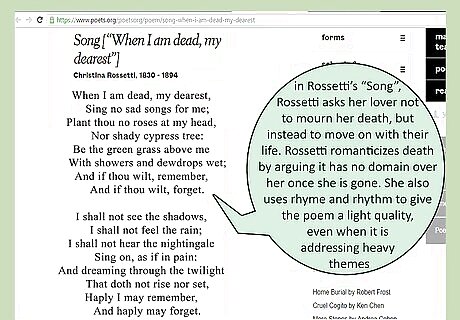
views
Understanding the Themes and Styles of Dark Poems

Learn the common themes in dark poetry. Most dark poetry focuses on emotions that may be morbid or disturbing. This could be feelings of loss, loneliness, death, depression, or anxiety. Dark poetry can act as a way to release these feelings and process these emotions. Many poets find dark poetry cathartic, almost like a form of therapy. There is also a sense of longing in dark poetry, as many dark poems romanticize death or dying. Often, poets see death existing right next to life. Death may be given sexual undertones or be portrayed as a figure of romance, but in a dark way.

Read examples of dark poetry. There are many examples of dark poetry, as this genre of poetry is popular among many different poets throughout literature. You may read several examples to get a better sense of the style and tone found in dark poems, including: “Song” by Christina Rossetti. “Minstrel Man” by Langston Hughes. "The Pond Museum" by Brandon Shimoda. "The morning after/my death" by Etel Adnan. "Romance Sonambulo" by Federico Garcia Lorca.

Analyze the examples. Once you have read over the examples, you should think about how each poet discusses darkness or dark themes in their work. Some poets may view darkness in terms of love and loss or darkness as more of a concept, where the speaker sees darkness in everyday moments or events. Ask yourself several questions about the poems, such as: How does the poet explore darkness in the poem? Does the poet focus on a specific moment of darkness? How does the poet use sensory detail and descriptive language to describe darkness? For example, in Rossetti’s “Song”, Rossetti asks her lover not to mourn her death, but instead to move on with their life. Rossetti romanticizes death by arguing it has no domain over her once she is gone. She also uses rhyme and rhythm to give the poem a light quality, even when it is addressing heavy themes. In comparison, Hughes’ “Minstrel Man” looks at how minstrel shows in America hide a lot of darkness in plain sight. His speaker is a minstrel man who performs racist shows for American audiences. Hughes contrasts the apparent joy and happiness the minstrel man performs for his audience with the pain and suffering he experiences internally. This gives the poem a disturbing quality that is finalized with the last line of the poem, “I die”.
Brainstorming Ideas for the Poem

Make a list of keywords that relate to darkness. To get your creative juices flowing, it may help to list keywords that relate to darkness and dark themes. Write darkness in the center of a piece of paper and then list words around the center that relate to darkness. Do not try to edit to your list or think too much as you write. The idea is to generate terms and words that conjure up darkness for you, which you can then use later when you sit down to write your poem. For example, around “darkness”, you may write “black”, “grey”, “death” “alone”, “anger”, “powerful”, and “hidden”. You could then try to integrate these terms into your poem or use a specific feeling, such as “anger”, as the inspiration for your poem.

Remember a moment when you felt sad, lonely, or depressed. One way to brainstorm ideas for your poem is to think about a specific moment when you experienced dark emotions, such as sadness, loneliness, or depression. Focusing on one specific moment and writing down words that relate to that moment can help you get ideas for the voice and tone of your poem. For example, maybe you recall a moment in the girl’s bathroom at school where you felt lonely or sad. You may then try to describe the scene and how it felt to be standing in the girl’s bathroom with these feelings.

Focus on a specific dark event. You may also decide to write about an event in your life that was particularly dark or difficult. Try to rely on your memories of the event and write about this event from your perspective. Doing this will make the poem feel intimate and honest. For example, maybe you relate a lot of dark emotions to the death of your grandfather. You may then try describing how it felt to attend his funeral and see him in his casket. You may also contrast memories of his death with memories of his life to give the poem levity.

Describe a person or place that signifies darkness to you. You may also focus on a specific person or place that represents darkness to you. Maybe a person pops into your head as soon as you think of darkness or a specific location that you have visited in the past. Describing a tangible thing, such as a person or place, can help you hone in on specific images for your poem. For example, maybe there is a next door neighbor who seems to represent darkness or dark emotions for you. Or, maybe there is a family relative that scared you as a kid. You may also remember a dark experience in a house you once lived in or associate dark feelings with a house in your neighborhood. Maybe there was a family vacation that you went on to a specific place in the States that you associate with dark or disturbing emotions.
Writing the Poem

Avoid cliches. When you are writing about subjects like darkness, sadness, loneliness, and death, it can be hard not to fall into cliches and familiar language. A cliche is a description that has been so overused it has lost its meaning. Many readers will gloss over a cliche and/or question the poet’s creativity when they come across a cliche. Avoid leaning on cliches in your writing and focus on creating more unique and unfamiliar ways of approaching darkness. Try to stay away from cliches like “dark as night”, “lost and alone” or “so lonesome I could cry”. Come up with more original descriptions and images in your poem, especially when you are addressing dark themes and elements. One way you can address cliches in your writing is to go over your poem and look for any familiar terms or phrases. You should then underline them and focus on replacing certain words or replacing the phrase so it is less familiar and feels more original.

Add sensory detail. Make sure you are using sensory detail in your poem, as this will make the poem come alive and contain descriptions that are memorable. Think about how a moment looks, sounds, tastes, smells, or feels. Use all five senses to create detailed moments in your poem. For example, maybe you are writing a poem about your grandfather’s death. You may focus on the smell of the white lilies at his grave or the gray, thin appearance of your grandfather in his casket. You may also describe the food you ate at his wake and the feeling of holding your grandmother’s hand at the funeral.

Use literary devices. Literary devices like metaphor, simile, and rhyme can help to strengthen the language in your poem and add depth to your writing. Try to use literary devices strategically, especially in a shorter poem. Every line should not be full of metaphors or similes only. You should vary up how you use these literary devices so your poem still flows well and does not seem wordy or long-winded. For example, you may use a metaphor to describe the loneliness of standing in the girl’s bathroom at school. You may write, “The stalls are blank eyes in the face of this room”. Or, you may use a simile to describe the look and smell of the bathroom. You may write, “The floor is as slick as the surface of a lake” and “The sinks smell like rotten eggs”. Some poets, such as Rossetti in “Song”, also use rhyme in their dark poetry. Rhyme can be useful for adding some levity and lightness to a poem about heavy, dark subject matter. But it can also make your poem sound too sing-songy and silly. Use rhyme sparingly.

Read your poem out loud. Once you have written your first draft, you should read your poem out loud to yourself or to a sympathetic audience. Listen for any awkward phrases or words and highlight them. Ask the listener for feedback on your writing. You should also pay attention to any images that are confusing or lines that are not as strong as they could be. Make sure you are not using cliches in your writing. Your poem should use unfamiliar and interesting images and descriptions that are true to your style and voice. You should go back and edit the poem for clarity once you have read it out loud. Adjust any problem phrases or words you identified and make sure you are using strong, interesting language throughout the poem.


















Comments
0 comment